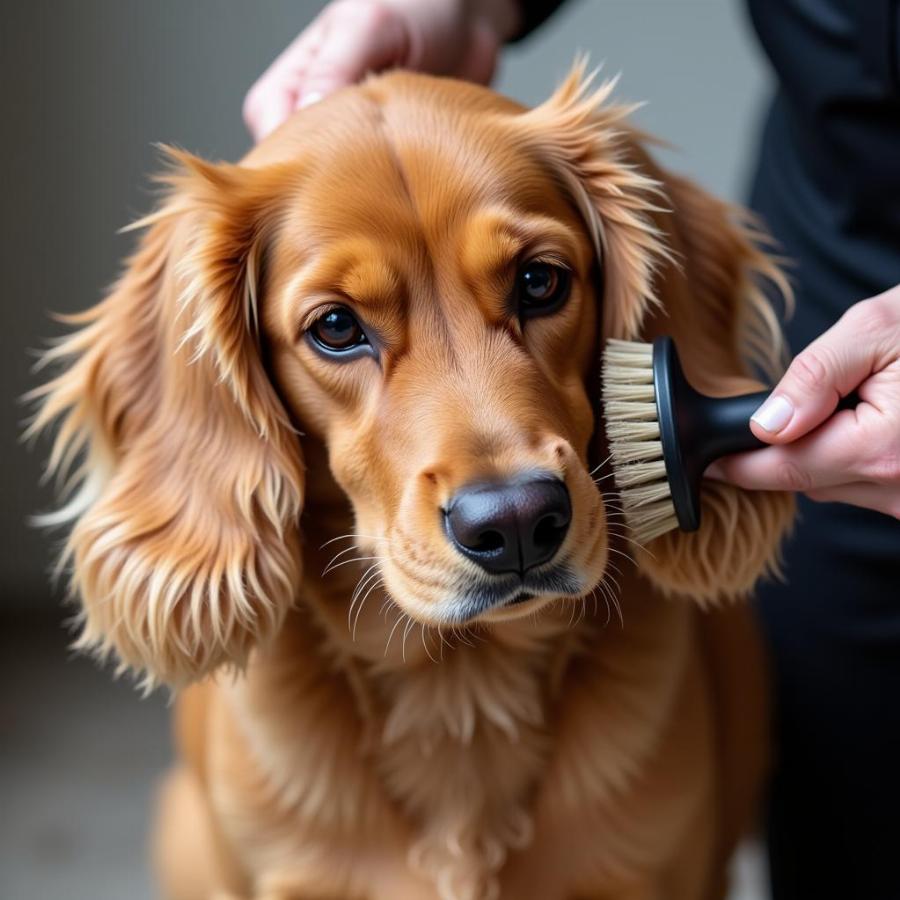Sable colour dogs are truly captivating with their unique and often mesmerizing coat patterns. But what exactly is a sable colour, and what can you expect if you’re considering welcoming a sable dog into your life? This article will delve into the intricacies of the sable colour in dogs, exploring its genetic basis, variations, and the breeds that commonly exhibit this stunning coat.
Decoding the Sable Colour Genetics
The sable colour in dogs is a result of a specific genetic interaction that creates a banded or tipped appearance on individual hairs. This banding is typically a darker colour, often black, over a lighter base coat colour, such as red, gold, or fawn. The result is a dynamic and multi-toned coat that can appear to shift and change in different lighting conditions. It’s this complex interplay of colours that makes sable dogs so visually striking.
The agouti gene plays a crucial role in determining the sable colour. This gene controls the distribution of pigment in the hair shaft, creating the characteristic banding pattern. Different variations of the agouti gene, along with other modifying genes, contribute to the diverse range of sable shades we see across different breeds.
Sable Colour Variations: A Spectrum of Beauty
The sable colour isn’t a one-size-fits-all phenomenon. It exists on a spectrum, with a wide range of variations in shade and intensity. From the clear sable, where the dark tipping is clearly defined against the lighter base, to the shaded sable, where the dark tipping is more diffused, creating a more subtle effect, the possibilities are truly diverse.
Some sable dogs exhibit tipping that is restricted to the back and tail, while others have a more uniform distribution of colour across their entire body. Understanding these variations can help you appreciate the unique beauty of each individual sable dog.
Dog Breeds that Sport the Sable Coat
While the sable colour can appear in various breeds, it’s particularly prevalent in certain breeds. German Shepherds, Shetland Sheepdogs, and Collies are perhaps the most well-known examples, often showcasing rich and vibrant sable coats. However, you can also find stunning sable individuals in breeds like Corgis, Pomeranians, and even some Spitz breeds.
If you’re interested in a sable dog colour, researching breeds known for this coat colour is a great starting point. Remember, however, that even within a breed, the expression of the sable colour can vary significantly.
Is a Sable Dog Right for You?
Beyond their striking appearance, sable dogs come with their own unique personalities and care requirements, just like any other dog. While the coat colour itself doesn’t dictate temperament or health predispositions, understanding the specific breed that carries the sable coat is crucial.
For example, a sable German Shepherd will have different exercise and training needs compared to a sable Pomeranian. Do your research and choose a breed that aligns with your lifestyle and experience level.
Sable Coat Care: Tips and Tricks
Caring for a sable coat requires understanding its specific needs. Regular brushing is essential to prevent matting and tangles, especially in breeds with longer, denser coats. Using a high-quality brush designed for your dog’s coat type can make a big difference.  Chăm sóc chó cảnh màu Sable
Chăm sóc chó cảnh màu Sable
Bathing should be done as needed, using a gentle shampoo formulated for dogs. Over-bathing can strip the coat of its natural oils, leading to dryness and dullness.
Conclusion: Embracing the Beauty of Sable
Sable colour dogs possess a unique allure, captivating hearts with their dynamic and multi-toned coats. From the intricate genetics behind the colour to the diverse range of variations, there’s much to appreciate about these stunning canines. Whether you’re drawn to the bold stripes of a clear sable or the subtle shading of a shaded sable, understanding the nuances of this coat colour can enhance your appreciation for the beauty and diversity of the canine world. Remember to research breeds known for dog breeds that are black and sable coats to find the perfect companion for you.
FAQ: Your Sable Colour Questions Answered
-
What causes the sable colour in dogs? The sable colour is a result of the agouti gene, which controls the distribution of pigment in the hair shaft, creating a banded appearance.
-
Are all sable dogs the same colour? No, the sable colour exists on a spectrum, with variations in shade and intensity.
-
What breeds commonly have sable coats? German Shepherds, Shetland Sheepdogs, and Collies are some of the most common breeds with sable coats.
-
Do sable dogs require special grooming? Regular brushing is essential to prevent matting and tangles, especially in breeds with longer coats.
-
Does the sable colour affect a dog’s temperament? No, the coat colour itself doesn’t dictate temperament. Temperament is determined by breed and individual personality.